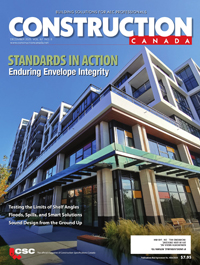Achieving safe spray foam insulation applications
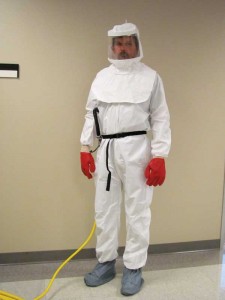
CAN/ULC S 705.1 also requires the product be “easily and uniquely identified on the jobsite.” Currently, manufacturers use different colours to identify their specific product.
During the installation process, quality assurance should be part of the contractor’s oversight. CAN/ULC S 705.2, Spray Application of Rigid Polyurethane Cellular Plastic Thermal Insulation for Building Construction, is the Canadian installation standard. It requires visual inspections, density testing, and adhesion testing throughout the job. Contractor daily work logs should contain the results of these inspections and tests, as well as sprayfoam chemical lot numbers and site conditions. These work logs help reinforce quality installation and can be useful if problems develop later.
In addition to the standards, blower door testing before drywall installation can identify any air leakage points. Lastly, the foam should be installed according to manufacturers’ guidance, which may recommend transition materials at openings and terminations, and expansion joints if necessary.
Even when SPF is safely and properly installed, there are additional considerations to ensure the home or building is safe and healthy for its occupants.
Adjusting HVAC design for SPF buildings
Building science experts indicate that while a facility cannot be constructed too airtight for efficiency and healthy indoor air quality (IAQ), it can be under-ventilated. Both commercial and residential buildings insulated with sprayfoam are often ‘tight,’ and will almost always require mechanical ventilation. This helps with both IAQ and humidity control. Typical strategies include using supply ventilation, exhaust ventilation, and balanced ventilation (i.e. heat- and energy-recovery ventilators [ERVs/HRVs]) to bring in the fresh air.
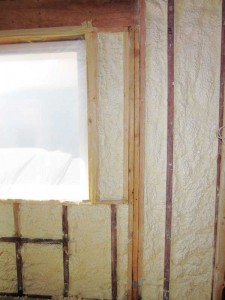
In the past, HVAC contractors often held a ‘more-is-better’ mantra regarding heating and cooling systems. However, SPF insulation allows for a significant reduction in the amount of heating and cooling required (often in the range of 40 per cent), so old rules of thumb with HVAC sizing no longer apply. (See “White Paper Proper Design of HVAC Systems for Sprayfoam Homes,” by Doug Garrett of Building Performance and Comfort Inc). Oversized systems will shortcycle and hurt efficiency, comfort, humidity control, and equipment life. With sprayfoam building envelopes, a Manual J load calculation should be performed to right-size the HVAC unit. (Manual J is the name for a specific protocol (often called “Heat Load Calculation” or “Cooling Load Calculation”) used to determine how much heating/cooling a home needs to stay cool and dry in the summer and warm in the winter. See Residential Energy Services Network [RESNET]).
Sealed combustion or power-vented furnaces and water heaters should be used whenever they are placed within a tight building envelope. This safeguards against flame or flue gas spillage backdrafting into the building in the event it undergoes depressurization.
HVAC installers must be familiar with sprayfoam building envelopes. Attention must be given to providing adequate fresh air ventilation, combustion safety, and humidity control to ensure the airtightness created by the SPF provides an ongoing return for the building owner in terms of comfort, energy cost savings, and safety.
Spreading the message
Achieving a high-quality, safe sprayed polyurethane foam application is not just about choosing the right contractor, but also about spreading the message within the industry and sharing best practices with others.
Sprayfoam schools––created and instructed by suppliers––are designed to share industry best practices. These typically include both classroom education and hands-on application and troubleshooting. The courses can also often provide the required industry certification.
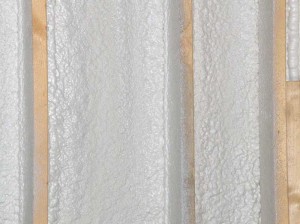
Topics covered should include:
- health and safety;
- material handling;
- equipment maintenance and operation;
- worksite preparation and spray application;
- troubleshooting;
- product storage;
- building science; and
- hands-on spraying techniques.
There are also numerous North American trade associations dedicated to the promotion of sprayfoam best practices. These include the American Chemistry Council’s Centre for the Polyurethanes Industry (CPI), the Spray Polyurethane Foam Alliance (SPFA), and CUFCA. (Visit www.spraypolyurethanefoam.org, www.sprayfoam.org, and www.cufca.ca for more information).
The Canadian Urethane Foam Contractors Association provides detailed requirements for sprayfoam fire performance as defined by Canadian building codes. Relevant sections for combustion and fire performance include:
- 3.1.4.2, “Protection of Foamed Plastics in Combustible Construction;”
- 3.1.5.11, “Combustible Insulation and its Protection in Noncombustible Construction;” and
- 3.1.11.2, “Firestopping in Wall Assemblies.”
Long-term impact
The safety measures are designed to mitigate the risks present during the actual SPF application. Once applied and cured, sprayfoam poses no risks to consumers, holding the same safety record as the polyurethane used in car seats, mattresses, and athletic sneakers.
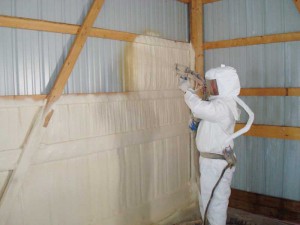
SPF insulation has the potential to impact not just a building owner’s heating and cooling costs, but also on a large scale, how Canada as a nation consumes energy. Safe, proper application ensures the initial investment in SPF will be quickly returned and provide energy savings for years to come.
Monica Karamagi is the regional marketing and industry affairs manager for Huntsman Polyurethanes. She currently serves as a member of the board of directors for the Spray Polyurethane Foam Alliance (SPFA), and co-chairs the Sprayfoam Safety Outreach workgroup as part of the Centre for the Polyurethanes Industry (CPI). Additionally, Karamagi represents Huntsman at the Council of North American Insulation Manufacturers (NAIMA). She can be reached via e-mail at monica_n_karamagi@huntsman.com.







